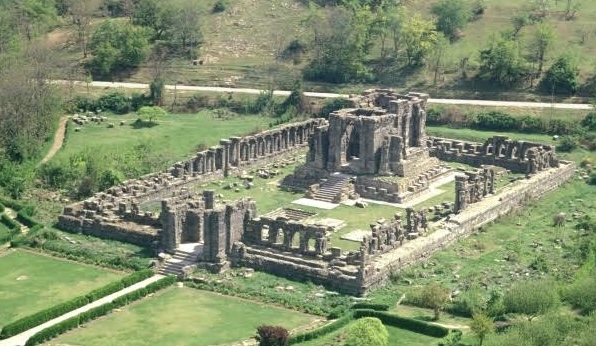By: Mr Khursheed Ahmad
Anantnag: Surya (also known as Aditya) is the Hindu god of the Sun. He is considered the creator of the universe & the source of all life. He is the supreme soul who brings light and warmth to the world.
Martand Temple named after eight son (Martanda) of Aditi
Although many hymns in the Rigveda mention him along with the other Adityas as a form of Surya. Vishnu had momentary manifestations (incarnations) of Matsya (fish), Varah(Bohr), Narasimha (lion man), after which he took the first birth avatar as Vamana, born to Aditi. Thus he too became Aditya.
Martand Temple is located in Gopalpore area of South Kashmir’s Anantnag district, there are three villages in Kashmir apparently named after Gopaditya (253 A.D. to 328)/ Kalhana’s Rajtarangani, Gopadityas (369-309 B.C.) but
out of these three villages (Gopal Pora) The Gopal Pora of Martand where temple was constructed is called as Kehribal (Kehar=means Destruction; Bal =means force ) apparently name of place was changed after The temple was completely destroyed on the orders of Muslim ruler Sikandar Butshikan in the early 15th century, with demolition (Kehar & Bal) lasting a year.
The origin of the Sun temple of Martand is a bit blurry, According to Kalhana, King Lalitaditya (A.D. 693 to 729) is believed to have built it. Major General Sir Alexander Cunningham (23 January 1814 – 28 November 1893) mentions that the Rajatarangini credits King Lalitaditya as the builder of Martand temples. But, he further mentions:
“From the same authority we gather — though the interpretation of the verses is considerably disputed — that the temple itself was built by Ranaditya, and the side chapels, or at least one of them, by his queen, Amritaprakha. The date ‘ of Ranaditya’s reign is involved in some obscurity, but it may safely be conjectured that he died in the first half of the fifth century after Christ.”
Sir Francis Edward Younghusband (31 May 1863 – 31 July 1942) in his book Kashmir (1911) mentions the temple believed to be dating back to 220 B.C. is Jyesthesvara Temple built atop a hill by Gopaditya (253 A.D. to 328)/ Kalhana’s Rajtarangani, Gopadityas (369-309 B.C.)
This is the site of present day Shiv temple atop Shankaracharya hill. The temple is first supposed to have been built by Jalauka, the son of great Emperor Ashoka, in around 200 B.C. The true date of the erection of this temple — the wonder of Kashmir is a disputed point of chronology; but the period of its foundation can be determined within the limits of one century, or between A.D 370 and 500.
The name Martand denotes a dead sun, or a sun that has sunk below the horizon.
The temple consists of one lofty central edifice with a small detached wing on each side of the entrance, the whole standing in a large quadrangle surrounded by a colonnade of fluted pillars, with intervening trefoil-headed recesses. The central building is 63 feet in length, by 36 feet in width at the eastern end, and only 27 feet at the western or entrance end.
” It contains three distinct chambers, of which the outermost one, named Arddha Mandapa, or the half-temple, answering to the front porch of the classical fanes, is 18 feet square. The middle one, called Antarala, or mid-temple, corresponding to the pronaos of the Greek, is 18 feet by 4 1/2 ; and the innermost one, named Oorbha Griho, or ” womb of the edifice,” the naos of the Greeks, and the cella of the Romans, is 18 feet by 3 1/2.
” The first and middle chambers are decorated, bat the inner is perfectly plain and closed on three sides. The walls are 9 feet thick, and its entrance-chamber only 4 1/2 feet thick, being respectively one-half and one-fourth of the interior width of the building.
” On each side of the porch, flush with the entrance wall to the westward, and with the outer walls, the northward and southward, is a detached building or wing, 18 feet long by 13 1/2 broad, with a passage 4 1/2 feet wide, between it and the wall of the entrance chamber.
” The width of the passage between these wings being exactly one-third of that of the wing itself, the roof which covered the two would have been an exact square, the form required as the basis of the pyramidal roof of the Kashmerian architecture, which had blended the Gandharan, Gupta, Chinese, Roman, Syrian-Byzantine and Greek forms of architecture.
” Within, the chamber had a doorway at each side, covered by a pediment with a trefoil-headed niche, containing a bust of the Hindu triad.
” This representation was itself only another symbol of the Sun, who was Brahma, or the Creator, at morn, Vishnu, or the Preserver, at noon, Siva, or the Destroyer, at even.
” The chamber was lighted during the day by semicircular openings over the closed doorways on the three sides, but in the evening, as the entrance was to the westward, the image of the
glorious sun was illumined by his own setting beams.
” The temple is enclosed by a pillared quadrangle 220 feet in length by 142 feet in breadth, containing 84 fluted columns. This number the Chourasi (84) of the Hindus is especially emblematic of the sun, as it is the multiple of the twelve mansions of the ecliptic (typified by 12 spokes in his chariot -wheel) through which he is carried by his seven steeds in one year ; or it is the product of his seven rays multiplied by the twelve signs of the Zodiac. The 84 pillars are therefore most probably intended for that number of solar rays. Thus, even the colonnade is made typical of the deity to whom the temple is consecrated.

